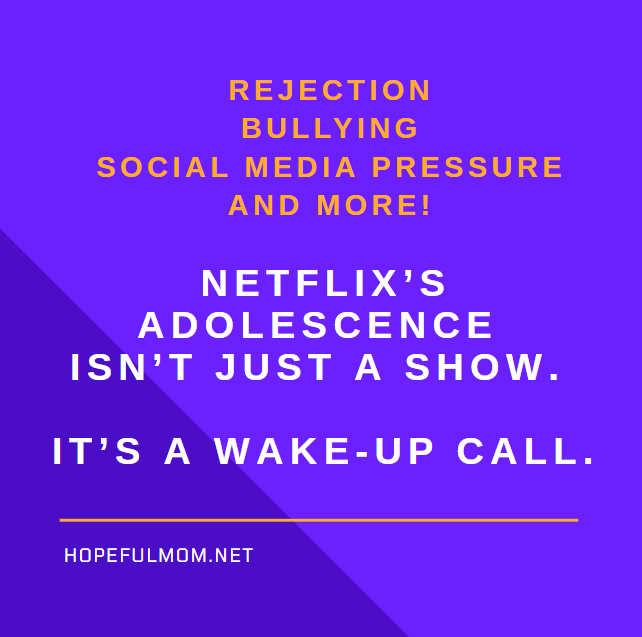Information about the Netflix series Adolescence filled my feed, but I resisted the urge to turn it on. I ignored the ads and scrolled past the comments. I didn’t want to watch.
My research can affect my mental health to the point that I must step away. When that happens, I view uplifting, positive, or humorous content. I press pause on social media and all things mentally exhausting or downright sad.
But after seeing post after post about the new record-breaking Netflix series Adolescence, I relented. Accounts I trust claimed the show was impactful and that the storyline mirrors what our teens face every day.
I finally watched Adolescence after reading this quote from Nicki Reisberg of Scrolling2Death:
“From what I’ve seen, the film is an accurate representation of what can and is happening to the underdeveloped brains of children when they are pushed addictive and harmful algorithms … It’s true that kids alone in their room with technology can be the most dangerous place in the world. … The bad stuff keeps the kids scrolling longer.”
Is Adolescence Appropriate for You or Your Teen?
In my opinion, this is a brilliant show. The filming, acting, and music are excellent. But that doesn’t mean it’s for everyone.
Before you watch, a few warnings—thanks to Andrea Davis of Better Screen Time.
Content: Adolescence is rated TV-MA (intended for adults). The show contains violence, sexual references, and an excessive number of f-bombs. Please follow your family’s media standards and don’t feel obligated to watch this show.
Realistic but Fictional: While the plot could be real, it’s a fictional representation of teen life.
Viewing this show isn’t necessary: The film offers a haunting insight into what our kids are up against, but it isn’t the only way to learn about these dangers. This alternative video explains dangers our children encounter and offers solutions: Our Kids Online: Porn, Predators, and How to Keep Them Safe.
That said, this series is emotionally intense with heavy themes. It offers a powerful window into what our teenagers deal with in the digital age. Many preteens and teens walk this same road, silently, while we go about our lives thinking they’re “just on their phones.”
What Adolescence Exposes About Teen Mental Health
This film doesn’t just explore the dark corners of the internet—it shines a spotlight on real-life issues:
- Bullying and Rejection
- Pornography
- Sending Nudes
- The Manosphere and Toxic Masculinity
- Social Media Pressure
- Isolation Caused by Tech in Bedrooms
The narrative follows a seemingly average teen boy from a loving home. His parents aren’t villains. Their choices are like many of ours: giving their son access to tech, trusting his judgment, and allowing devices in his room.
But even good kids from good homes can spiral when left alone with an internet built to exploit their insecurities. Let’s recognize the battlefield they’re navigating so we can fight back.
Message for Adults
Adolescence isn’t just about preteens and teens. The adults around the kids didn’t grasp the immense influence the screens had until it was too late.
The Netflix series Adolescence begs us to listen to our children. When they say school is hard, pay attention. When they withdraw, don’t dismiss the behavior as “teen angst.” When they open up, engage.
Educate and communicate. The following posts may be helpful:
Tech in bedrooms isn't safe. Netflix Adolescence shows why. Here’s what the show got right—and what we need to do as parents. What Netflix Adolescence Reveals About Teen Mental Health & Tech #DigitalParenting #ScreenTime Share on XSteps We Can Take
1. Make Bedrooms Tech-Free Zones
Sleep and solitude should be protected spaces, not gateways to dangerous content. Removing screens from bedrooms reduces late-night scrolling, exposure to harmful content, and emotional dysregulation.
2. Talk to Your Kids About the Pressures They Face
Many teens struggle in silence, overwhelmed by rejection, confusion about femininity and masculinity, and the constant comparison game of social media. Create space for open, ongoing conversations.
3. Call Out the Toxic Content
The manosphere is more than just edgy commentary—it’s a pipeline into misogyny, entitlement, and harmful worldviews. Equip your child to recognize it and critically question what they see. The manosphere and online pornography aren’t “harmless phases.” They shape how young men (and women) view themselves, women, and relationships. Let’s bring these topics into the light and teach them to question what they’re consuming.
4. Mentor and Monitor
Parenting in the digital age isn’t about spying. It’s about guiding. Teach your child how to use tech intentionally, recognize manipulation, and set healthy boundaries.
5. Model What You Preach
Your tech habits set the tone. If you’re always on your phone, expect resistance when you ask them to log off. Show them what digital discipline looks like.

We Can’t Afford to Look Away
In the end, Netflix ’s Adolescence isn’t just a show. It’s a wake-up call. Not one meant to shame parents—but to urge us toward a more conscious, connected way of raising our children.
Yes, it’s heavy. But sometimes heavy stories are exactly what we need to help us understand the weight of our responsibilities. So, even if you choose not to watch the show, heed the message.
Let’s not wait for a crisis to start the conversation. Your child’s mental health and future are worth every uncomfortable moment.
Please subscribe to Hopeful Mom for two FREE PDF downloads: 7 Steps After Your Child Sees Porn AND Sexpectations Reflection Questions. For information on modeling habits of healthy relationships, read Sexpectations: Helping the Next Generation Navigate Healthy Relationships.
About the author
Barb Winters is the author of Sexpectations: Helping the Next Generation Navigate Healthy Relationships and founder of Hopeful Mom. She’s a certified mental health coach and offers one-on-one consultations for parents. For more about Barb, click "About" in the menu.



